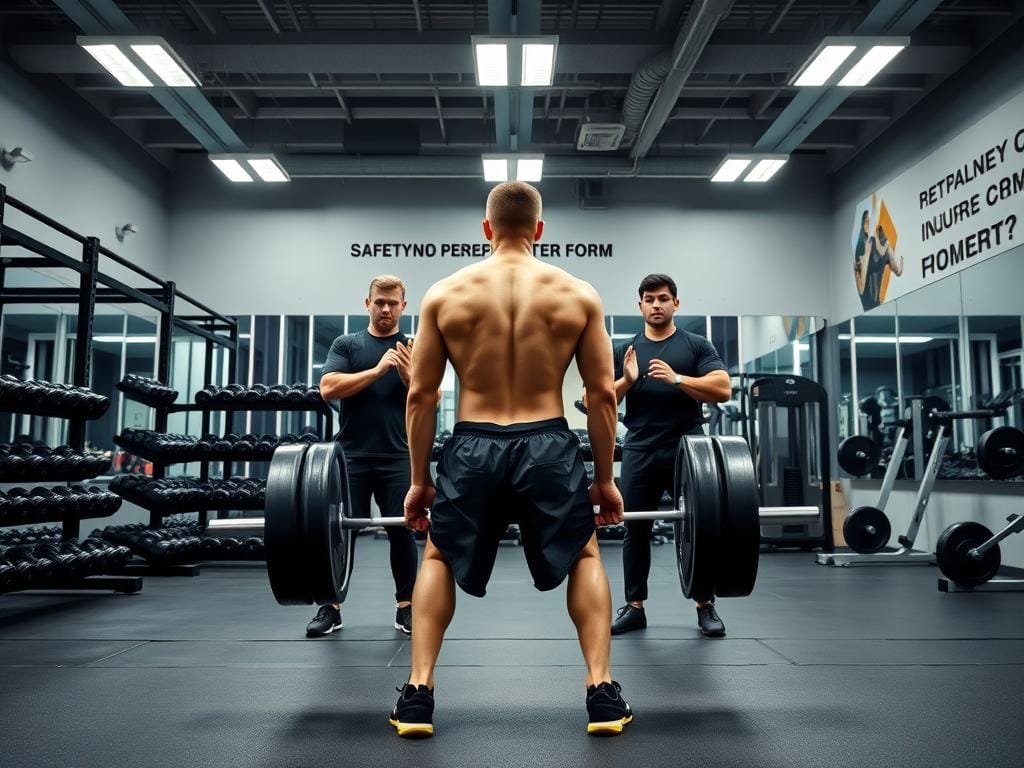Did you know that weight training can boost your metabolism and increase strength? Starting a new exercise routine can seem scary, but with the right help, you can succeed. Weight training uses weights like dumbbells and barbells to challenge your muscles and improve fitness.
By focusing on strength building and stamina improvement, you can boost your health and wellbeing. As you get better, you’ll find it easier to do daily tasks and have more energy all day.
Table of Contents
Key Takeaways
- Weight training is essential for building strength and stamina.
- Beginners can start with simple exercises using dumbbells and kettlebells.
- Consistency is key to seeing improvements in overall fitness.
- Proper form and technique are vital to avoid injury.
- A well-rounded fitness routine includes strength training and cardio exercises.
The Fundamentals of Weight Training for Beginners
For beginners, knowing the basics of weight training is key to a good fitness journey. Weight training, or resistance training, helps improve muscle fitness. It works by exercising a specific muscle or group against outside resistance.
What Is Weight Training and How It Builds Muscle
Weight training uses weights, bands, or your body to challenge muscles. It causes micro-tears in muscle fibers. As your body repairs these, your muscles get stronger and bigger, a process called muscle hypertrophy.
To build muscle well, eat the right foods and rest enough. For a detailed muscle building workout plan, look at resources that offer structured advice.
Key principles of effective weight training include progressive overload, where you gradually increase the weight or resistance. Consistency is also key, ensuring you train regularly to see improvement.
Strength vs. Stamina: Understanding the Difference
Strength and stamina are two important fitness areas. Strength is the ability of your muscles to exert force against resistance, like the maximum weight you can lift. Stamina, or muscular endurance, is the ability to sustain activity over time.
Weight training can boost both strength and stamina, depending on your workout structure. Lifting heavier weights with fewer reps builds strength. Lighter weights with more reps improve stamina.
Knowing the difference between strength and stamina helps you tailor your workouts. This way, you can aim to lift heavier or do daily tasks with more energy.
Science-Backed Benefits of Regular Weight Training
Weight training is more than just building muscle. It’s a way to improve your health in many ways. Adding weight training to your routine can bring many benefits to your life.
Physical Transformations: Muscle Growth and Fat Loss
One key benefit of weight training is muscle growth. When you use weights, your muscles get stronger. This makes your body more toned and powerful.
Weight training also helps with fat loss. It makes your body burn more calories, even when you’re not working out. This can help you lose fat, if you eat right too.

| Physical Benefit | Description |
|---|---|
| Muscle Growth | Increased muscle mass through resistance training |
| Fat Loss | Enhanced metabolism leading to fat reduction |
| Bone Density | Improved bone health reducing the risk of osteoporosis |
Mental and Hormonal Benefits of Resistance Training
Weight training also boosts your mental health. It can make you feel less anxious and depressed. It can also make you happier and more mentally well.
It also helps with hormonal balance. It can make your body better at handling sugar and improve your thyroid and growth hormone levels. This is good for your health.
Research shows that weight training can also improve sleep quality and lower blood pressure. This is great for your overall health and happiness.
Getting Started: Equipment and Spaces You’ll Need
Starting your weight training journey can be done at home or the gym. Each has its own benefits. Working out at home is convenient, private, and can save money.
Home Training Essentials: Minimal Equipment Options
You don’t need a lot of equipment to start weight training at home. Here are some basics:
- Dumbbells: Versatile and essential for various exercises.
- Resistance Bands: Lightweight, portable, and great for strength training.
- Kettlebells: Excellent for dynamic movements and full-body workouts.
- Adjustable Bench: Useful for a variety of exercises, including bench presses and step-ups.
Start with these basics and add more as you get more comfortable. For more information, visit Healthline’s guide on how to start lifting.
Gym Options: Navigating Commercial Fitness Centers
Gyms offer a lot if you like the gym environment. Here are some benefits:
- Variety of Equipment: Access to a wide range of machines and free weights.
- Group Classes: Opportunities to join classes for motivation and social interaction.
- Personal Trainers: Professional guidance to help you achieve your fitness goals.
When choosing a gym, think about location, hours, and equipment availability during busy times.
Finding Certified Trainers and Gyms in Your Area
Finding a certified trainer can really help your weight training. Here are some tips:
- Check Certifications: Look for certifications from reputable organizations like ACE or NASM.
- Read Reviews: Check online reviews and testimonials from other clients.
- Ask for Referrals: Friends, family, or coworkers can be great sources of recommendations.
For gyms, visit them in person. This lets you see the environment and meet with trainers or staff.
Safety First: Preventing Injuries in Weight Training
When you start weight training, safety is key to avoid injuries and enjoy your fitness journey. As a beginner, it’s easy to get excited about lifting weights. But, ignoring safety can lead to serious problems. Proper safety measures protect you from injuries and make your training better.

Proper Warm-Up Protocols for Weight Training
A good warm-up is vital before weight training. It gets your muscles ready, boosts blood flow, and lowers injury risk. A good warm-up includes light cardio exercises and dynamic stretches that match your workout.
For example, a leg day warm-up might be jogging or cycling, then leg swings and lunges. This gets your muscles and mind ready for the workout.
“A proper warm-up is like laying the foundation for a successful workout. It’s not just about preventing injuries; it’s about optimizing your performance.” – Certified Fitness Trainer
When to Use Spotters and Safety Equipment
Spotters and safety gear are key to avoid injuries, mainly with heavy weights. A spotter helps if you struggle with a lift. Safety equipment, like squat racks, catches the weight if you fail.
- Use spotters for exercises like bench presses and squats, where the risk of injury is higher.
- Ensure that your gym has safety equipment and that you know how to use it properly.
Recognizing Your Limits as a Beginner
Knowing your limits is critical in weight training. As a beginner, it’s tempting to push too hard, too fast. But, recognizing and respecting your limits helps avoid overtraining and injuries.
Begin with lighter weights and slowly add more as you get stronger and more confident. Pay attention to your body; if you’re tired or in pain, it’s okay to slow down and rest.
Mastering Proper Form: The Foundation of Effective Training
Effective weight training starts with learning proper form. “Good form is the key to unlocking the full potentia of your workout while minimizing the risk of injury,” fitness experts say. It ensures you target the right muscles and get the results you want.

Body Positioning and Alignment Fundamentals
Correct body positioning and alignment are key in weight training. It’s about knowing the right posture, stance, and movement for each exercise. For example, keeping your back straight and engaging your core makes your lifts more effective and safer.
To get better at body positioning, focus on slow and controlled movements. This makes your exercises more effective and helps prevent injuries. As you master proper form, you’ll lift more efficiently and safely.
Breathing Techniques During Different Lifts
Breathing is important in weight training. It helps stabilize your core and boosts your performance. For instance, exhaling when lifting and inhaling when lowering can improve your control and strength.
It’s key to practice breathing that matches your lifts. This helps improve your performance and keeps your form right, even with heavy loads.
Using Mirrors, Video, and Feedback to Perfect Form
Mirrors and video recordings are great for improving your form. They let you see and adjust your movements. Mirrors give you instant feedback, while videos offer a detailed look at your technique.
Getting feedback from trainers or experienced lifters is also helpful. They can point out what you’re doing right and what needs work. Remember, “Practice doesn’t make perfect; perfect practice makes perfect.” Using self-assessment tools and expert feedback helps you refine your form and get better results.
10 Essential Weight Training Exercises for Building Strength
To build strength, you need a balanced weight training program. It should target all major muscle groups. Focus on exercises that work multiple muscles at once. This helps build overall strength and endurance.
Upper Body Strength Builders
Upper body strength is key for daily activities and fitness. Here are some important exercises to add to your routine:
- Bench Press: Works your chest, shoulders, and triceps.
- Dumbbell Rows: Targets your back and biceps.
- Shoulder Press: Strengthens your shoulders and triceps.
- Bicep Curls: Isolates your biceps for increased arm strength.
- Tricep Dips: Effective for building tricep strength.

Lower Body Power Foundations
A strong lower body is essential for stability, mobility, and strength. Add these exercises to your weight training routine:
- Squats: Works your quadriceps, hamstrings, and glutes.
- Deadlifts: Targets multiple muscle groups including your back, legs, and glutes.
- Lunges: Strengthens your legs and improves balance.
- Leg Press: Isolates your quadriceps, hamstrings, and glutes.
- Calf Raises: Targets your calf muscles for lower leg strength.
| Exercise | Primary Muscles | Secondary Muscles |
|---|---|---|
| Squats | Quadriceps, Hamstrings, Glutes | Core, Lower Back |
| Deadlifts | Back, Legs, Glutes | Core, Shoulders |
| Lunges | Legs, Glutes | Core, Lower Back |
Core Strengthening Fundamentals
A strong core is the base of overall strength and stability. Include these exercises in your routine:
- Planks: Strengthens your core and improves posture.
- Russian Twists: Targets your obliques.
- Leg Raises: Works your lower abs.
- Bicycle Crunches: Targets your entire core.
By adding these essential weight training exercises to your routine, you’ll build overall strength and endurance.
Designing Your First Weight Training Program
Creating your first weight training program is about knowing your goals and what equipment you have. It’s also about how often you can work out. You need to think about your fitness level, the gear you have, and your training schedule.
Frequency: Optimal Training Schedule for Beginners
Beginners should start with a three-day split. This means you train three days a week and rest the other days. This schedule helps your muscles recover and grow stronger.
Benefits of a Three-Day Split:
- Allows for adequate recovery time
- Improves muscle growth and strength
- Fits well into a busy schedule
Sample 3-Day Full Body Routine with Progressive Structure
A full-body routine works out many muscles at once. It’s perfect for those with little time to train. Here’s a sample 3-day full-body routine:
| Exercise | Day 1 (Monday) | Day 2 (Wednesday) | Day 3 (Friday) |
|---|---|---|---|
| Squats | 3 sets of 8-12 reps | 3 sets of 9-13 reps | 3 sets of 10-14 reps |
| Push-ups | 3 sets of 8-12 reps | 3 sets of 9-13 reps | 3 sets of 10-14 reps |
| Lunges | 3 sets of 8-12 reps (per leg) | 3 sets of 9-13 reps (per leg) | 3 sets of 10-14 reps (per leg) |
| Deadlifts | 3 sets of 8-12 reps | 3 sets of 9-13 reps | 3 sets of 10-14 reps |
This routine gets harder as you get stronger. It keeps challenging you and helping you grow.
Adapting Your Program to Home or Gym Settings
Your program should work whether you’re at home or in a gym. At home, you can use bodyweight exercises, resistance bands, or dumbbells. In a gym, you have more machines and free weights to use.
Tips for Home Training:
- Use resistance bands for added resistance
- Invest in a set of dumbbells
- Bodyweight exercises like push-ups and squats are effective
Tips for Gym Training:
- Learn to use various machines for different muscle groups
- Free weights like dumbbells and barbells offer versatility
- Consider working with a personal trainer to learn proper form
By knowing your goals and adjusting your program to your setting, you can make progress in your weight training.
Progressive Overload: The Science of Getting Stronger
Progressive overload is key in weight training. It helps you get stronger and more fit over time. It’s about slowly adding more weight or resistance to challenge your muscles.
Understanding Load, Repetitions, and Sets
To use progressive overload well, you must know about load, repetitions, and sets. Load is the weight or resistance you use. Repetitions are how many times you do an exercise. A set is a group of these repetitions.
For example, doing 3 sets of 10 squats with 100 pounds means you’re doing 3 groups of 10 squats with that weight.
Changing these variables helps you challenge your muscles and get stronger. You can lift more weight, do more reps, or do more sets.
Strategic Methods to Increase Training Intensity
To increase your training intensity, try these methods:
- Use heavier weights or more resistance.
- Add more reps or sets to your routine.
- Take less rest between sets and exercises.
- Try harder exercises or variations.
For example, you can boost your metabolism by doing more intense workouts.
Tracking Your Progress with Journals and Apps
It’s important to track your progress to see if you’re getting stronger. Use workout journals or apps to log your exercises, weights, and reps. This helps you see patterns, stay motivated, and adjust your routine as needed.
Some good ways to track progress include:
- Keeping a workout log to record your exercises and weights.
- Using apps like MyFitnessPal or Strava to track your workouts.
- Taking progress photos and measurements.
By watching your progress, you can make your workout routine better. This helps you reach your strength and stamina goals faster.
Building Stamina Through Weight Training Circuits
Boost your endurance with weight training circuits. This method combines strength and endurance training. It helps you reach a higher fitness level.
Combining Strength and Endurance Training
Strength and endurance training together boost stamina. This combo builds muscle and improves heart health. Weight training circuits are great because they keep your heart rate up while working different muscles.
“Circuit training is excellent for muscle endurance and heart health,” says a fitness expert. It involves doing exercises one after another with little rest. This challenges your muscles and heart.
HIIT and Weight Training Hybrid Workouts
HIIT and weight training make a powerful workout. HIIT has short, intense exercises followed by brief rests. This mix boosts strength and stamina.
- Improves cardiovascular health
- Enhances muscular endurance
- Increases caloric burn during and after workout
Rest Periods: Balancing Recovery and Cardiovascular Challenge
Rest periods are vital in weight training circuits. They let your muscles recover. But, the length of rest affects the workout’s heart challenge. Shorter rest periods boost heart health, while longer ones help in strength.
Finding the right rest balance is essential. Start with short rests and increase them as you get stronger. This way, you build endurance and challenge your heart effectively.
Adding weight training circuits to your routine and managing rest periods boosts stamina and fitness. Remember, staying consistent and patient is key to reaching your fitness goals.
Nutrition and Recovery for Optimal Results
Starting your weight training journey? Knowing about nutrition and recovery is key. Good nutrition fuels your workouts and helps with recovery. Also, having the right recovery strategies means you’re ready for the next session.
Protein Requirements for Muscle Building
Protein is essential for building and repairing muscles. Eating enough protein boosts muscle growth and strength. Aim for 1.2 to 1.6 grams of protein per kilogram of body weight each day. Spread it over 3-5 main meals.
Example Protein-Rich Foods:
- Chicken breast
- Fish
- Eggs
- Greek yogurt
- Legumes
| Food | Protein Content per Serving |
|---|---|
| Chicken breast | 31g per 3 oz serving |
| Fish (Salmon) | 20g per 3 oz serving |
| Eggs | 6g per large egg |
Pre and Post-Workout Nutrition Strategies
What you eat before and after workouts matters a lot. Eating a balanced meal with carbs and protein 1-3 hours before can boost your performance. After working out, eating carbs and protein within 30-60 minutes helps with recovery and muscle repair.
For more tips on what to eat after a workout, check out Healthline’s article on what to eat after a workout.
Sleep, Stress Management, and Active Recovery
Getting enough sleep, managing stress, and doing active recovery are key to a successful weight training program. Aim for 7-9 hours of sleep each night to help with muscle recovery and growth. Activities like yoga or meditation can help keep cortisol levels in check, which is good for muscle growth and recovery.
Active recovery techniques like light cardio, stretching, or foam rolling improve circulation and reduce muscle soreness. They’re great for your recovery routine.
Conclusion: Embracing Your Strength and Stamina Journey
Starting a weight training journey can change your life. It boosts your physical and mental health. You can begin with just 30 minutes, 2-3 times a week. This can lead to stronger muscles, a faster metabolism, and denser bones.
You can start your journey at home with light dumbbells and exercise bands. Adding cardio to your routine can help you lose fat and keep your heart healthy. For more tips, check out Lemon8.
Remember, rest is key for muscle growth and repair. Stay committed to your fitness journey. You’ll see big changes in your health and confidence.

